High-Grade Glioma Relapse in Children: Onxeo Announces the Enrollment of the First Patient in the Phase 1b/2 Clinical Study Conducted by the European ITCC Consortium and Sponsored by Institut Curie
Onxeo S.A. (Ticker: ONXEO) announced the enrollment and treatment of the first patient in its phase 1b/2 clinical study for AsiDNA, a first-in-class DNA Damage Response inhibitor. This trial targets relapsed High-Grade Glioma (HGG) in children and adolescents. With HGG accounting for 20% of CNS tumors in children and a grim 5-year survival rate below 20%, this study aims to demonstrate efficacy and tolerability when combined with radiotherapy. The trial is sponsored by Institut Curie and aims to enroll 32 patients, with interim results expected in Q1 2024.
- Enrollment of the first patient in the phase 1b/2 trial for AsiDNA, a promising treatment for relapsed HGG.
- AsiDNA has shown synergetic effects with radiotherapy in preclinical and initial adult trials.
- HGG remains a challenging cancer with a 5-year survival rate of less than 20%.
- The trial involves a limited patient population of only 32, which may affect the robustness of results.
Insights
Analyzing...
High Grade Gliomas (HGG), which represents approximately
This phase 1b/2 trial, sponsored by Institut Curie, is being conducted within the framework of the European ITCC4 consortium, in order to evaluate AsiDNA’s efficacy and tolerability by enrolling a maximum of 32 patients (children, adolescents or young adults) with relapsed HGG. A first patient has been enrolled in the study at the Institut Curie’s SIREDO (Soins, Innovation, Recherche en cancérologie de l’Enfant, l’aDOlescent et l’adulte jeune, i.e. care, innovation, research in cancer in children, adolescents and young adults) Center. Additionally, other French centers as well as European countries are planned to be initiated in the coming months. The study’s first interim results are projected in the first quarter of 2024.
“The enrollment of the first patient is a major step in this proof-of-concept study whose goal is to evaluate the efficacy and good tolerability of the systemic administration of AsiDNA in combination with a new radiotherapy. We hope that this study will provide encouraging evidence enabling an improvement in the prognostic outcome of a disease that is a key unmet need”, added Prof.
This phase 1b/2 study is supported by a grant from the European Fight Kids Cancer5 program.
About Institut Curie
Institut Curie, French leading center for the fight against cancer, has an internationally renowned research center and a state-of-the-art group that treats all types of cancer, including the rarest. Founded in 1909 by
For further information: www.curie.fr
Since 2011, Institut Curie is "Institut Carnot Curie Cancer" certified. The Carnot label is a label of excellence awarded to academic research structures that have demonstrated quality and involvement in collaborative research. Curie Cancer offers industrial partners an opportunity to set up research cooperation while benefiting from Institut Curie teams’ expertise in developing innovative therapeutic solutions to fight cancer, from therapeutic target to clinical validation. Curie Cancer is a member of the Carnot FINDMED network, a group of thirteen Carnot institutes, in order to facilitate access to their technological platforms and innovation capabilities for very small, small and medium-sized companies, SMEs and SMIs in the pharmaceutical sector.
For further information: www.instituts-carnot.eu/fr/institut-carnot/curie-cancer
About
platON is Onxeo’s proprietary chemistry platform of oligonucleotides acting as decoy agonists, which generates new innovative compounds and broaden the Company’s product pipeline.
AsiDNA, the first compound from platON, is a highly differentiated, clinical-stage first-in-class candidate in the field of DNA damage response (DDR) applied to oncology. Its decoy and agonist mechanism acting upstream of multiple DDR pathways results in distinctive antitumor properties, including the ability to prevent or abrogate tumor resistance to targeted therapies such as PARP inhibitors and strong synergy with tumor DNA-damaging agents such as radio-chemotherapy. AsiDNA is currently being studied in
OX400 is a series of new drug candidates from platON, designed to be a next-generation PARP inhibitor acting on both the DNA Damage Response and the activation of immune response, without inducing resistance. The lead OX400 candidate is currently being optimized and is undergoing preclinical proof-of-concept studies, alone and in combination with immunotherapies.
For further information, please visit www.onxeo.com.
Forward looking statements
This communication expressly or implicitly contains certain forward-looking statements concerning
1 The company reminds shareholders that the delisting of
2 In 2016,
3 “First-in-human phase I study of the DNA repair inhibitor DT01 in combination with radiotherapy in patients with skin metastases from melanoma.” Le Tourneau C et al. Br
4 The Innovative Therapies for Children with Cancer (ITCC) consortium is a non-profit organization incorporating 63 European pediatric oncology departments with expertise in conducting early-stage trials in children and adolescents and 25 European research laboratories.
5 Fight Kids Cancer is a European call for projects, a joint initiative of France’s Imagine for Margo association, Belgium’s KickCancer foundation and Luxembourg’s Kriibskrank Kanner foundation.
View source version on businesswire.com: https://www.businesswire.com/news/home/20220901005777/en/
Investor Relations
investors@onxeo.com
+33 1 45 58 76 00
Media Relations
Arthur Rouillé
NewCap
onxeo@newcap.eu
+33 1 44 71 94 98
Investor Relations / Strategic Communication
Dušan Orešanský /
NewCap
onxeo@newcap.eu
+33 1 44 71 94 92
Institut Curie
Media relations
Certified Adviser for Nasdaq First North
Kapital Partner
www.kapitalpartner.dk
info@kapitalpartner.dk
+45 89 88 78 46
Source:







